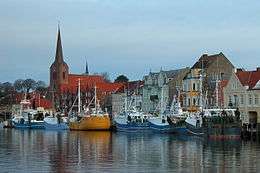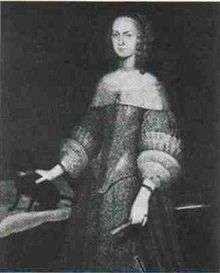Als (island)
 Sønderborg Harbour | |
 | |
| Geography | |
|---|---|
| Location | Little Belt |
| Coordinates | 54°59′N 09°55′E / 54.983°N 9.917°ECoordinates: 54°59′N 09°55′E / 54.983°N 9.917°E |
| Area | 321 km2 (124 sq mi) |
| Administration | |
|
Denmark | |
| Region | South Denmark Region |
| Municipality | Sønderborg Municipality |
| Largest settlement | Sønderborg (pop. 27,194) |
| Demographics | |
| Population | 51,322 (2010) |
| Pop. density | 154.5 /km2 (400.2 /sq mi) |
Als (Danish pronunciation: [alˀs], German: Alsen) is a Danish island in the Baltic Sea.
Geography
Als lies to the east of the Jutland peninsula, across from the Danish town of Sønderborg, and north of the coast of Southern Schleswig, Germany. Covering an area of 321 km2 (124 sq. miles), the island has a total population of 51,322 as of 1 January 2010.[1] It is administered as part of the Sønderborg Municipality as of 1 January 2007.
To the north and east of the island are the waters of the Little Belt, to the south is Flensborg Fjord, and to the west is Als Fjord and Als Strait (Alssund).
The town of Sønderborg is the capital, and was originally entirely on the island, but has spread onto the mainland, being split by the waters of Als Strait: the strait that separates the island from Jutland, the Danish mainland and part of Als Fjord. It has a good harbour, considerable trade, and the two halves of the city are connected over the fjord by two bridges: the 682 metre long Als Strait Bridge (Alssundbro), built between 1978 and 1981, carries road traffic; and the 331 metre long King Christian X's Bridge (Kong Christian Xs Bro), built between 1925 and 1930, which originally carried both road and rail traffic but is now purely for road traffic.[2]
Ferry services are run from the town of Hardeshøj on the island to Ballebro on the Jutland mainland, and from the town of Fynshav to Søby on the island of Ærø and to Bøjden on the island of Funen.
Als is a fertile island with a thriving pig breeding industry. The island was formerly known for its fruit orchards, some of which are still in operation.
The west coast of the island has many bays and coves: Stegsvig, Sandvig, Ketting Nor, Lille Hav, Augstenborg Fjord, Kær Vig, Hørup Hav, and Dyvig. On the east coast along the Little Belt lies the 7 km2 Northern Forest (Nørreskov), and Lake Nordborg (Nordborg Sø).
Nordborg municipality is the home to a number of larger businesses including Danfoss, Denmark's largest industrial company, Sauer-Danfoss and Linak, one of Denmark's fastest growing companies.
History
There are many archeological finds that show the island has been inhabited from the late Stone Age. From the Bronze Age comes the Hjortspring Boat).
During the Middle Ages the island come under the influence of a number of noblemen, each of which ruled over their portion of the island, and its citizens. King Christian III's son, Duke John, came in possession of the island as a titular Duchy, and he bought the other noblemen out. The island was again divided into several smaller Duchies later on, but this venture failed eventually.


The town of Augustenborg grew up around Augustenborg Palace which was established in the years after 1651 by Ernest Günther, a member of the ducal House of Schleswig-Holstein (its branch of Sønderborg), great-grandson of King Christian III, and a cadet of the royal house of Denmark. The palace, and the town consequently, received the name in honor of Ernest's wife Auguste, who was also from a branch of the Dukes of Schleswig-Holstein.
The palace became the chief seat of their line which used the name Augustenborg as its branch name. Later a Danish king made the head of that line specifically Duke of Augustenborg. They grew in relative prominence in late 18th century, and the Duke of Augustenborg became the dominating person on the island.
The Duchy was taken over by the Danish Crown after the last Duke of Augustenborg to live at the palace, Christian August II, had sided with the Schleswig-Holstein pro-German nationalistic movement against Denmark. He left on March 18, 1848.
That same year during the First War of Schleswig (1848–1851), the Danes directed their main attack against Fieldmarshal Friedrich Graf von Wrangel's Austro-Prussian army from the lighthouse on the peninsula of Kegnæs at the southwest end of Als. In 1864 the Battle of Als took place there. In 1870 Als was fortified by Prussia.
Under the two wars over which nation would rule the island, and the following period under Prussian and German rule, the island's population was largely Danish. In 1920 Als returned to Danish rule following a referendum.
After 1920 Als has been marked by growing industry, especially after 1945 when Danfoss grew into an international corporation.
The Augustenburg line died out in the 20th century.
Attractions
The town of Sønderborg is home to Sønderborg Castle (Sønderborg Slot) and Sandbjerg Estate (Sandbjerg Gods). Sønderborg castle is located in the centre of the town, and houses a museum focusing on the history and culture of the area. The museum is open year-round. Sandbjerg Estate, which had belonged for many years to the Dukes of Sønderborg, and then to the Reventlow family, was donated to Aarhus University in 1954.
The island's Augustenborg Palace has been converted into a hospital. There is an exhibit about the castle, the town and its ducal history in the building's entryway. The castle church is open to the public in the summertime, and tours are given.
Image gallery
-

Augustenborg Castle
-
Havnbjerg beach
-
Lusig beach
-

Sønderby
-
Nordborg Church
-

Katholm island
-

Nørreskoven in the north of Als
-

Danfoss headquarters at Nordborg
-
Ferry harbour at Fynshav
-

King Christian X's Bridge at Sønderborg
-
Svenstrup Church
See also
References
- ↑ "Danmarks Statistik." Retrieved 28 June 2010.
- ↑ "Als", Den store Danske. (Danish) Retrieved 28 June 2010.
External links
| Wikimedia Commons has media related to Als. |
